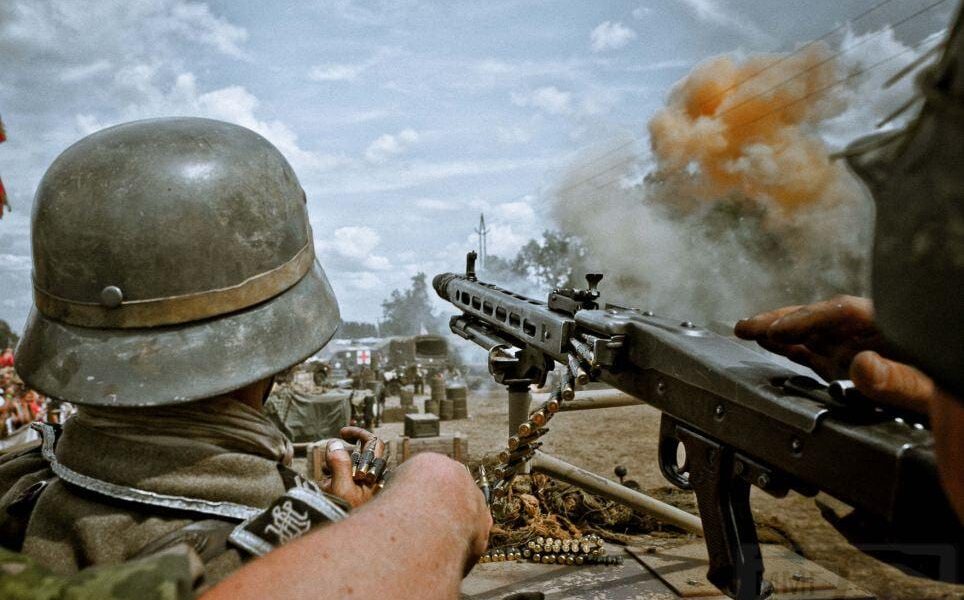In August 1939, these two powerful nations concluded a surprise non-aggression pact, agreeing to a ten-year period without conflict.
This pact, known as the Molotov-Ribbentrop Pact, was not just a simple agreement, but a strategic move that reshaped the map of Europe.
Under these conditions, the Soviet Union gained control over Lithuania, Estonia, Latvia and the eastern half of Poland.
This allowed Nazi Germany to invade the western half of Poland without Soviet interference. Adolf Hitler did so on September 1, 1939, just nine days after signing the pact that marked the beginning of World War II in Europe.

Sometime in the autumn of 1942, Soviet soldiers advance through the rubble of Stalingrad.
Despite the pact, neither Germany nor the Soviet Union harbored any illusions about their future. They anticipated an inevitable clash, but used the agreement to bide their time.
Hitler, the opportunist, focused on expanding Nazi influence in Western and Central Europe and quickly conquered France, Denmark, Belgium and other countries.
Meanwhile, Joseph Stalin strengthened his iron grip on the Soviet Union and consolidated its power with vigor.

In the winter of 1942, the inhabitants of Leningrad drew water from a broken water main during the nearly 900-day siege by German invaders. Failing to capture the city, the Germans isolated it, cut off supplies, and bombarded it for over two years.
On June 22, 1941, the picture of the Second World War changed dramatically.
With the launch of Operation Barbarossa, a massive invasion of the Soviet Union, Hitler shattered the German-Soviet non-aggression pact.
From the Baltic Sea in the north to the Black Sea in the south, three to four million Axis soldiers advanced, including many non-Germans such as Hungarians, Romanians, Finns, etc.
In just one week, German troops had advanced 320 kilometers into Soviet territory.
Within a few months, 2.5 million Soviet soldiers were dead, wounded, or missing. By December, this number had risen to nearly 7 million.

A German grenadier with a machine gun on his shoulder in front of a burning building during the German retreat to the Soviet Union, 1944.
The fighting was exceptionally brutal. Executions and mass rapes were commonplace.
Instead of deporting Jews and Roma to concentration camps, the 3,000-strong German Einsatzgruppen executed civilians in their own towns and villages, resulting in the mass murder of over a million people, often through mass shootings.
However, with the onset of the bitterly cold Russian winter, the Germans were confronted with reality in a harsh way.
Hitler, who expected a rapid collapse of the Soviet Union, declared: “We only have to kick in the door and the whole rotten building will collapse.”
This meant that the Germans were unprepared for a prolonged conflict.

During the Siege of Leningrad in 1943, the hippo Belle survived the war thanks to her caretaker, Yevdokia Dashchina. When the city’s water supply was cut off in 1941, Belle’s pool dried up, causing her skin to crack. Every day, Dashchina fetched a 40-liter barrel of water from the Neva River to bathe Belle and rubbed her with camphor oil. This dedication eventually healed Belle’s skin and allowed her to seek underwater refuge during air raids.
The Nazis also underestimated the enormous distances their campaign would have to cover. Moscow, located 1,600 kilometers east of Berlin, proved to be a formidable target.
When the German troops reached the outskirts of Moscow, they were overwhelmed.
The Red Army took advantage of this, successfully defended Moscow and pushed back the Germans – a decisive moment in the war.
Hitler sought a strategic victory in 1942 by attacking Stalingrad , a key industrial city in southwest Russia.
Stalingrad was an important artillery producer for the Soviet armed forces and, due to its location on the Volga River, an important shipping route to the Black and Caspian Seas.

In December 1942, an abandoned horse stands in the ruins of Stalingrad.
The Battle of Stalingrad was the largest and bloodiest conflict in military history.
For five brutal months, the city endured relentless German air raids and fierce close-quarters fighting.
The result was shocking: 2 million people were killed, wounded or captured, including many civilians
Both sides suffered heavy losses, but the German army, encircled in Stalingrad, finally surrendered to the Soviets.
This surrender marked one of the most decisive turning points of the war and forced the Germans into a steady retreat, which finally culminated in their surrender on May 9, 1945, after the Battle of Berlin.
The photographs collected here, brought to life in color, depict the bloody battles and everyday fighting on the Eastern Front of the Second World War.

In 1943, female Red Army snipers meet before heading to the front.

Soviet soldiers attack during the Siege of Leningrad. January 1, 1943.

Three Russian war orphans stand amidst the remains of their former home at the end of 1942. After German troops destroyed the family’s house, they captured the parents and left the children alone.

Red Army soldiers raise the Soviet flag over the Reichstag during the Battle of Berlin. May 2, 1945.

In the autumn of 1942, a German soldier is seen hanging a Nazi flag on a building in downtown Stalingrad.

On June 26, 1941, German soldiers, supported by armored personnel carriers, advance into a burning Belarusian village at an unknown location.

In June 1943, Soviet soldiers lying on their backs fire a volley of bullets at enemy aircraft.

In October 1942, a German Junkers Ju 87 “Stuka” dive bomber attacked during the Battle of Stalingrad.

At the end of 1943, an aerial photograph shows the ruins of Stalingrad, almost completely destroyed after six months of brutal warfare.


Romanian soldiers are pulled by a camel on the Stalingrad Front. September 1942.

Captured Jewish civilians who participated in the Warsaw Ghetto Uprising are driven out of the city by Nazi troops, Warsaw, Poland, April 19, 1943.

Heinrich Himmler inspects a prisoner of war camp in Russia. Circa 1941.

On August 4, 1942, a German armored car can be seen amidst the rubble of the Soviet fortress in Sevastopol, Ukraine.

Soviet snipers fight during a blizzard on the Leningrad Front. 1943.

Ukrainians welcome the Wehrmacht.

A Soviet woman watches a building burn sometime in 1942.

Young girls assemble machine guns in a Soviet factory. 1943.

During their campaign in Poland in 1940, German soldiers pass Adolf Hitler.

Ukrainian cavalrymen parade in front of Hans Frank, the Nazi Governor-General of occupied Poland. Lviv, Ukraine. September 1939.

An elderly German woman walks through the smoking ruins of Berlin after the city was taken over by the Red Army. 1945.
German prisoners of war captured during the Battle of Stalingrad, 1943.

A line of German soldiers stretches to the horizon as they march to their prison camps after being expelled from their last strongholds near Stalingrad in 1943.

The commander of a Cossack unit on active duty in the Kharkov region of Ukraine, on June 21, 1942.

In February 1943, a Soviet soldier stands guard behind a captured German soldier. After months of being encircled by Soviet troops in Stalingrad, the remnants of the German Sixth Army surrendered. The fierce fighting and starvation had already claimed the lives of around 200,000 soldiers.




